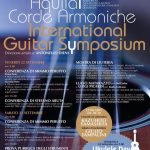STRINGS
A classical guitar is first of all a resonance box that, by vibrating, amplifies the sounds coming from each individual string: this is the driver that causes the instrument to vibrate through the bridge, and emerge thanks to the virtuosity of the guitarist. Thus the strings act as “acoustic impedance adapters” between the musician and the instrument.
The set of strings one uses exert a precise “level” of preload on the soundboard of the instrument; that is why ignoring the laws and phenomena that give them their character is tantamount to passively accept their effects, whatever they be, thus forfeiting the opportunity to exploit them to obtain a better sound from each instrument, something which curtails a musician’s possibility to fully express him / herself.
The in-depth knowledge of sound dynamics is therefore of fundamental importance both at the stage of:
The set of strings one uses exert a precise “level” of preload on the soundboard of the instrument; that is why ignoring the laws and phenomena that give them their character is tantamount to passively accept their effects, whatever they be, thus forfeiting the opportunity to exploit them to obtain a better sound from each instrument, something which curtails a musician’s possibility to fully express him / herself.
The in-depth knowledge of sound dynamics is therefore of fundamental importance both at the stage of:
• design and
• instrument set-up
Consequently, it is of fundamental importance for a designer of musical instruments to have a solid in-depth knowledge of the strings’ behavior, both in static and dynamic conditions. Such a knowledge is essential in the phases of:
• instrument design
• instrument set-up
Here are some of the tests I carry out on strings during their design phases:
- Spectral analysis
- Time wearing out analysis
- Analysis of the transient and of the resonance slew rate
- Full-scale signal analysis at the steady state and study of the signal curve and its linearity
Here are some of the tests I carry out on strings during their design phases:
- Spectral analysis
- Time wearing out analysis
- Analysis of the transient and of the resonance slew rate
- Full-scale signal analysis at the steady state and study of the signal curve and its linearity.
Having said this, my interest in the world of string design for classical guitar arose because I was dissatisfied with the strings normally available on the market. Striving to make the soundboard more sensitive to vibratory modes did not distract me from dealing with the problems inherent in the response that many types of strings offered to a guitarist’s fingers. Some battles must be fought upstream, not downstream; it is useless to strive to make the soundboard hypersensitive if excessive rigidity persists in the strings.
Guitar strings are like the set of tires for formula 1 cars or GP motorbikes: you can have the best car, or the best motorbike, but if you don’t have the right tires ... you will never be able to take advantage of them 100%.
I therefore collaborated with those string manufacturers who were willing to investigate in depth the vibratory modes, the materials and manufacturing processes that go into making them: all this in order to obtain improvements at the very source of sound.
I then investigated whether, and how, it was possible to “measure” the expressive capacity of a string, which attains its highest expression in gut strings.
In the end I succeeded in creating a physical model which enabled me to study the qualitative characteristics of the strings. This enable me to devise a parameter which I called “modulability angle”.
It allows me to measure the aptitude of a string to “sing”, thus making it possible to measure its expressive capacity. In other words, it spells out the “expressive” capacity of a string, its “acoustic malleability”, obtained through techniques such as the vibrato.
It allows me to measure the aptitude of a string to “sing”, thus making it possible to measure its expressive capacity. In other words, it spells out the “expressive” capacity of a string, its “acoustic malleability”, obtained through techniques such as the vibrato.
Needless to say, the highest “angle of modulation” value to date is found in gut strings, but the discovery of this parameter has allowed me to “measure” how close synthetic strings can come to it.
The angle of modulation is determined by several factors:
1) Material
2) Absolute diameter
3) Relative diameter (under load, in tuned string)
4) Diameter reduction (after specific treatments)
5) % linear shortening
6) Stretching
7) Implemented diameters
8) Regularity of string section geometry





